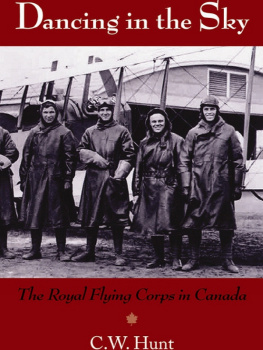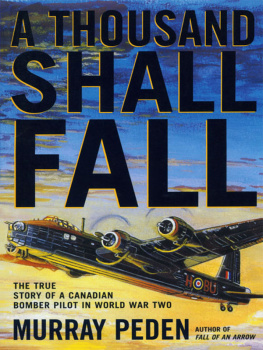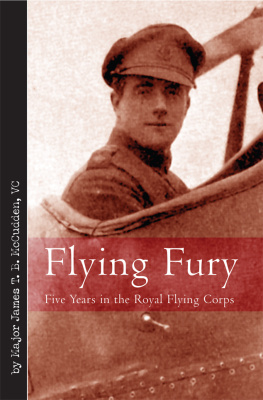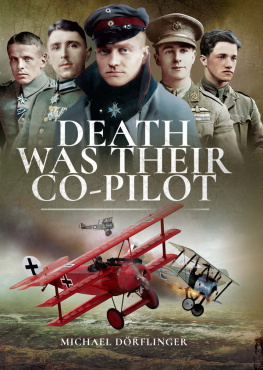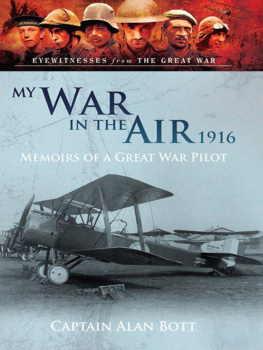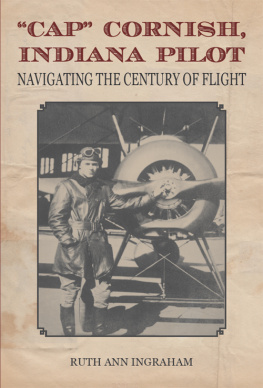
Dancing in the Sky
Dancing in the Sky
The Royal Flying Corps in Canada

C.W. Hunt

DUNDURN PRESS
TORONTO
Copyright C.W. Hunt, 2009
All rights reserved. No part of this publication may be reproduced, stored in a retrieval system, or transmitted in any form or by any means, electronic, mechanical, photocopying, recording, or otherwise (except for brief passages for purposes of review) without the prior permission of Dundurn Press. Permission to photocopy should be requested from Access Copyright.
Copy-editors: Shannon Whibbs and Andrea Waters
Design: Courtney Horner
Printer: Webcom
Library and Archives Canada Cataloguing in Publication
Hunt, C. W. (Claude William)
Dancing in the sky : the Royal Flying Corps in
Canada / by C.W. Hunt.
Includes bibliographical references and index.
ISBN 978-1-55002-864-5
1. Great Britain. Royal Flying Corps. 2. World War, 1914-1918-Aerial operations, British. 3. World War, 1914-1918--Aerial operations, Canadian. I. Title.
UG639.C3H85 2008 940.4'4941 C2008-903963-7
1 2 3 4 5 13 12 11 10 09

We acknowledge the support of the Canada Council for the Arts and the Ontario Arts Council for our publishing program. We also acknowledge the financial support of the Government of Canada through the Book Publishing Industry Development Program and The Association for the Export of Canadian Books, and the Government of Ontario through the Ontario Book Publishers Tax Credit program, and the Ontario Media Development Corporation.
Care has been taken to trace the ownership of copyright material used in this book. The author and the publisher welcome any information enabling them to rectify any references or credits in subsequent editions.
J. Kirk Howard, President
Published by Natural Heritage Books
A Member of The Dundurn Group
Printed and bound in Canada.
www.dundurn.com
This book is dedicated to William Taylor Hunt
journalist and photographer (1966-2005)
TABLE OF CONTENTS
This book began when RCAF Captain (Ret.) J. Alan Smith gave me material he had collected over twenty years of research. We agreed that I would write a book about it. Smith had interviewed former members of the Imperial Royal Flying Corps (IRFC), thereby preserving their experiences for posterity. As a result of our meeting, I set out on a journey that lasted a decade.
My brother, Pete Hunt, a detailed and thorough researcher, uncovered a great deal of information while combing through hundreds of newspapers. Many of the vignettes that flesh out the book are the result of his research.
I was always graciously assisted by Elizabeth Mitchell and Marie Wright of the Belleville Library. Marci Weese of Queen's University Library was particularly helpful. Euan Callender assisted in the early research.
Deseronto archivist Ken Brown guards his photos and documents more ferociously than any junkyard dog, but generously made several photos and documents available for use in the book. Master Warrant Officer Normand Marion at CFB Borden provided capable assistance on the material available there. He took me on a knowledgeable tour of a few of the original hangars that were built for temporary use in 1917 but still stand today.
Glen Martin of Fort Worth, Texas, researched the Texas camps over several years and provided information not available in Canada. The taped interviews of Texans long dead provided a useful insight into the social life of the British and Canadian airmen stationed in Texas during the winter of 1917-1918.
The National Archives, Canadian War Museum, and the Canadian Forces Directorate of History are treasure troves of information. The documents held by these institutions were essential in providing a detailed understanding of the Royal Flying Corps/Royal Air Force (RFC/ RAF) training scheme in Canada. My thanks also to The Hastings County Historical Society, which has a small but excellent collection of photos from the Rathbun and Mohawk camps.
My late son, William Taylor Hunt, read parts of the manuscript. An excellent stylist, he helped clarify the work. Professor (emeritus) Arthur Bowler read the entire manuscript and made many useful suggestions, all of which I acted upon. Ren Duinker provided invaluable assistance with the photographs.
If I have missed anyone who assisted with the project, I apologize. My only excuse being that a project taking a decade to complete challenges an imperfect memory. My wife, Milli, was unwavering in her support and never complained of her status as a writer's widow. My thanks for her generous forbearance.
Any errors or omissions are entirely those of the author.
The Royal Flying Corps' plan to train pilots in Canada marked a dramatic turning point in the military relationships between Canada, Britain, and the United States. Today, that close alliance is taken for granted, yet, for over a century, both Britain and Canada regarded the emerging American giant with a mixture of envy and foreboding. In the last decade of the nineteenth century, relations had deteriorated to the point where the United States was threatening to go to war against Britain over an obscure boundary dispute in Venezuela.
The antipathy between the three nations had deep roots. During the American Civil War, Britain barely disguised its hope the American Union would break into two weaker nations; a divided America posed less of a threat to the hegemony of the British Empire. Canadians, on the other hand, were deeply suspicious of American expansionism. In the election of 1911, Sir Wilfrid Laurier proposed a reciprocity trading agreement with the United States. The proposed agreement was highly favourable to Canada, but the expression of annexationist sentiments by some American politicians so alarmed Canadians they defeated the popular Laurier, thereby killing a trade agreement that would have meant greater prosperity for the majority of the population. Canadians were so fearful of the United States that they threw out of office one of the most popular prime ministers in the nation's history because he had advocated a trading treaty that might have led to closer relations with the United States.
The memory of America's invasions into Canada during the War of 1812, the Fenian raids, plus the American desire to absorb Canada was etched deeply into the national consciousness. Despite Canada's fears and American resentment of British imperialism, Canadians and Americans joined in an Air Force Training Plan run by the British on both Canadian and American territory. The Plan was the beginning of the close alliance between the three nations that is now taken as a fundamental principle of their respective foreign policies.
At the outbreak of the conflict in Europe, both Canada and the United States had fallen far behind the British and the Europeans in aircraft technology. The Plan was the primary agent in dragging both Canada and the United States into the age of modern aviation.
While the Canadian government was a reluctant participant in the training scheme, its passive participation resulted in so many Canadians mastering the art of flying that it was Canadians and not Americans who mapped and pioneered the North American Arctic, thereby ensuring that this vast territory would fly the Maple Leaf rather than the Stars and Stripes.
Next page
